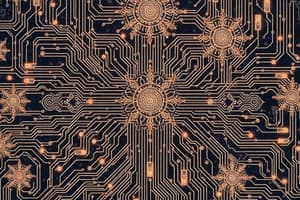Podcast
Questions and Answers
What is the primary purpose of a decoder in combinational circuits?
What is the primary purpose of a decoder in combinational circuits?
- To detect errors in digital communication
- To select one of many input signals and route it to a single output (correct)
- To convert binary data into a decimal format
- To perform arithmetic operations like addition and subtraction
Which flip-flop is particularly effective for toggling output states based on input signals?
Which flip-flop is particularly effective for toggling output states based on input signals?
- T Flip-Flop (correct)
- JK Flip-Flop
- SR Flip-Flop
- D Flip-Flop
Which of the following is NOT a characteristic of synchronous sequential circuits?
Which of the following is NOT a characteristic of synchronous sequential circuits?
- Behavior dependent on a clock signal
- State changes occur simultaneously
- Utilization of memory elements without feedback (correct)
- State transitions determined by clock edges
An excitation table is commonly used for which type of circuit component?
An excitation table is commonly used for which type of circuit component?
Which of the following best defines a priority encoder?
Which of the following best defines a priority encoder?
What is the main difference between synchronous and asynchronous flip-flops?
What is the main difference between synchronous and asynchronous flip-flops?
What is the primary function of multiplexers in combinational circuits?
What is the primary function of multiplexers in combinational circuits?
Which of the following is a key feature of a counter?
Which of the following is a key feature of a counter?
In the design of sequential circuits, what is typically represented in a timing diagram?
In the design of sequential circuits, what is typically represented in a timing diagram?
Which method describes how excitation tables are used for flip-flops?
Which method describes how excitation tables are used for flip-flops?
Flashcards
Combinational Circuits
Combinational Circuits
Circuits where the output depends only on the current input values, not on any previous inputs.
Sequential Circuits
Sequential Circuits
Circuits where the output depends on current and past inputs.
Flip-Flops
Flip-Flops
Memory elements used in sequential circuits to store one bit of information.
JK Flip-Flop
JK Flip-Flop
Signup and view all the flashcards
Registers
Registers
Signup and view all the flashcards
What does an encoder do?
What does an encoder do?
Signup and view all the flashcards
What is a multiplexer (MUX)?
What is a multiplexer (MUX)?
Signup and view all the flashcards
What is a D flip-flop?
What is a D flip-flop?
Signup and view all the flashcards
What is a state table?
What is a state table?
Signup and view all the flashcards
What is a counter?
What is a counter?
Signup and view all the flashcards
Study Notes
Combinational Circuits
- Adders: Circuits performing arithmetic addition.
- Decoders: Transform binary codes into unique signals.
- Encoders: Convert multiple input signals into a coded output.
- Priority Encoders: Select highest priority input.
- MUX (Multiplexers): Choose one input to send to the output.
- Design of Combinational Circuits: Methods for building circuits based on Boolean logic.
Sequential Circuits
- Latches: Memory elements storing a single bit of data.
- Flip-Flops: Memory elements storing a single bit, with clock control.
- JK Flip-Flop (JKFF): Specific type of flip-flop based on J and K inputs.
- D Flip-Flop (DFF): Flip-flop where the input directly determines the output.
- T Flip-Flop (TFF): Toggle flip-flop, outputs toggle on each clock pulse.
- Excitation Tables: Show next state of flip-flops based on current state and inputs.
- Synchronous and Asynchronous Flip-Flops: Classifications based on clock signal control.
- Clocks: Control signals regulating sequential circuit actions.
- State Table: Formal representation of states, inputs, and outputs in a table.
- State Diagram: Graphical representation of the state transitions.
- Timing Diagram: Shows the timing relations between inputs, outputs, and clock pulses.
- Design of Sequential Circuits: Methods for building circuits using states and flip-flops.
- Registers: Memory elements storing multiple bits of data.
- Counters & Their Design: Circuits incrementing or decrementing, utilizing flip-flops.
Studying That Suits You
Use AI to generate personalized quizzes and flashcards to suit your learning preferences.





